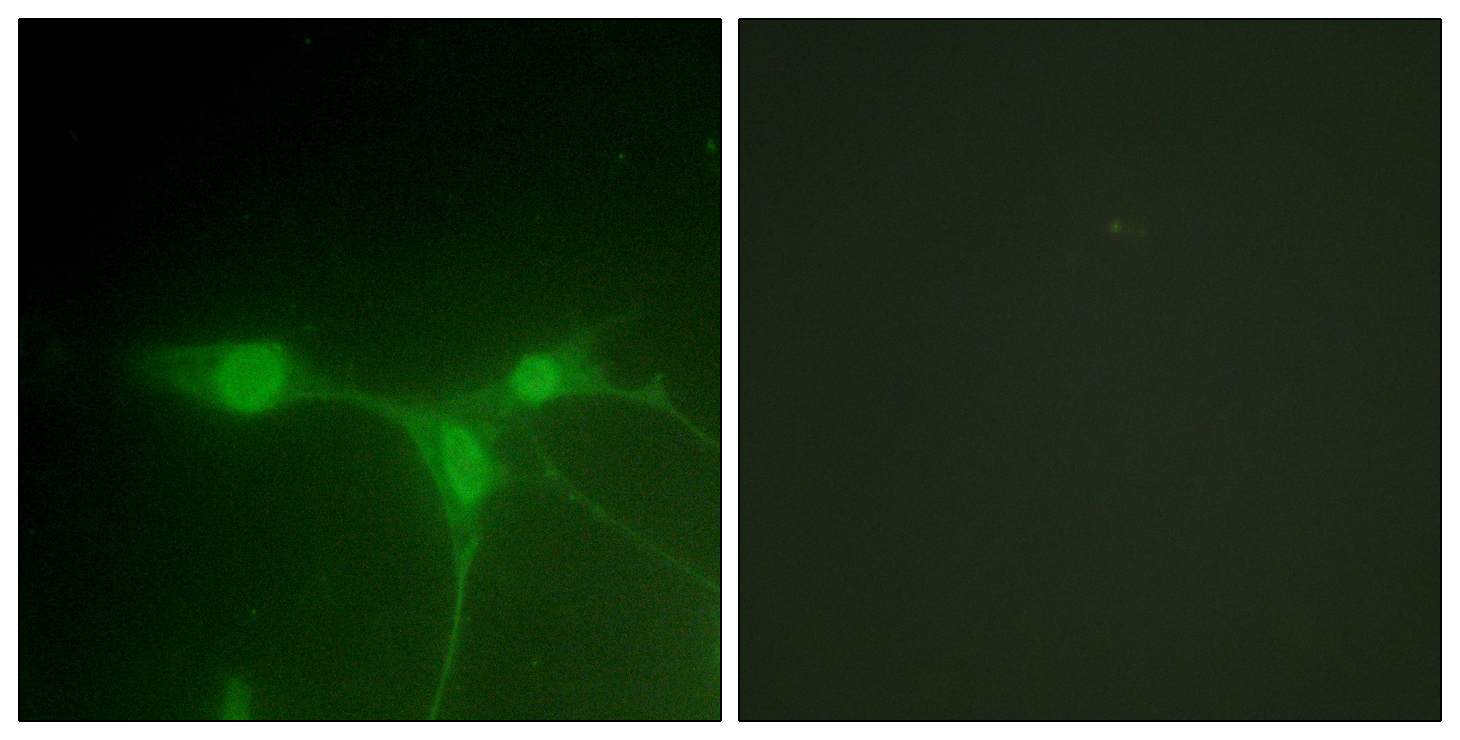Brk Polyclonal Antibody
- Catalog No.:YT0525
- Applications:IF;ELISA
- Reactivity:Human;Mouse
- Target:
- Brk
- Gene Name:
- PTK6
- Protein Name:
- Protein-tyrosine kinase 6
- Human Gene Id:
- 5753
- Human Swiss Prot No:
- Q13882
- Mouse Swiss Prot No:
- Q64434
- Immunogen:
- The antiserum was produced against synthesized peptide derived from human Breast Tumor Kinase. AA range:402-451
- Specificity:
- Brk Polyclonal Antibody detects endogenous levels of Brk protein.
- Formulation:
- Liquid in PBS containing 50% glycerol, 0.5% BSA and 0.02% sodium azide.
- Source:
- Polyclonal, Rabbit,IgG
- Dilution:
- IF 1:200 - 1:1000. ELISA: 1:20000. Not yet tested in other applications.
- Purification:
- The antibody was affinity-purified from rabbit antiserum by affinity-chromatography using epitope-specific immunogen.
- Concentration:
- 1 mg/ml
- Storage Stability:
- -15°C to -25°C/1 year(Do not lower than -25°C)
- Other Name:
- PTK6;BRK;Protein-tyrosine kinase 6;Breast tumor kinase;Tyrosine-protein kinase BRK
- Molecular Weight(Da):
- 52kD
- Background:
- protein tyrosine kinase 6(PTK6) Homo sapiens The protein encoded by this gene is a cytoplasmic nonreceptor protein kinase which may function as an intracellular signal transducer in epithelial tissues. Overexpression of this gene in mammary epithelial cells leads to sensitization of the cells to epidermal growth factor and results in a partially transformed phenotype. Expression of this gene has been detected at low levels in some breast tumors but not in normal breast tissue. The encoded protein has been shown to undergo autophosphorylation. Alternative splicing results in multiple transcript variants. [provided by RefSeq, Jan 2012],
- Function:
- catalytic activity:ATP + a [protein]-L-tyrosine = ADP + a [protein]-L-tyrosine phosphate.,enzyme regulation:Activated enzyme seems to have greater access to its substrates.,function:Phosphorylates KHDRBS1, KHDRBS2, KHDRBS3 and STAP2/BKS. May function as an intracellular signal transducer in epithelial tissues. Overexpression in mammary cells leads to mitogenically sensitization to EGF, and results in a partially transformed phenotype. Its presence in the nucleus appears to be linked to suppression of tumor progression.,PTM:Autophosphorylated. The phosphorylation of Tyr-447 may lead to the autoinhibition of the enzyme.,similarity:Belongs to the protein kinase superfamily. Tyr protein kinase family. BRK/PTK6/SIK subfamily.,similarity:Contains 1 protein kinase domain.,similarity:Contains 1 SH2 domain.,similarity:Contains 1 SH3 domain.,subcellular location:Colocalizes with KHDRBS1, KHDRBS2 o
- Subcellular Location:
- Cytoplasm. Nucleus. Cell projection, ruffle. Membrane . Colocalizes with KHDRBS1, KHDRBS2 or KHDRBS3, within the nucleus. Nuclear localization in epithelial cells of normal prostate but cytoplasmic localization in cancer prostate.
- Expression:
- Epithelia-specific. Very high level in colon and high levels in small intestine and prostate, and low levels in some fetal tissues. Not expressed in breast or ovarian tissue but expressed in high percentage of breast and ovarian cancers. Also overexpressed in some metastatic melanomas, lymphomas, colon cancers, squamous cell carcinomas and prostate cancers. Also found in melanocytes. Not expressed in heart, brain, placenta, lung, liver, skeletal muscle, kidney and pancreas. Isoform 2 is present in prostate epithelial cell lines derived from normal prostate and prostate adenocarcinomas, as well as in a variety of cell lines.
- June 19-2018
- WESTERN IMMUNOBLOTTING PROTOCOL
- June 19-2018
- IMMUNOHISTOCHEMISTRY-PARAFFIN PROTOCOL
- June 19-2018
- IMMUNOFLUORESCENCE PROTOCOL
- September 08-2020
- FLOW-CYTOMEYRT-PROTOCOL
- May 20-2022
- Cell-Based ELISA│解您多样本WB检测之困扰
- July 13-2018
- CELL-BASED-ELISA-PROTOCOL-FOR-ACETYL-PROTEIN
- July 13-2018
- CELL-BASED-ELISA-PROTOCOL-FOR-PHOSPHO-PROTEIN
- July 13-2018
- Antibody-FAQs
- Products Images

- Immunofluorescence analysis of NIH/3T3 cells, using Breast Tumor Kinase Antibody. The picture on the right is blocked with the synthesized peptide.



